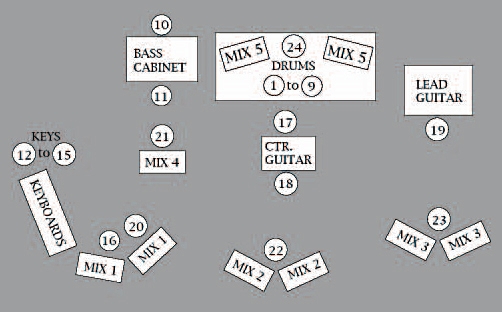
You Didn’t Ask
I looked up by the drum riser on one stage and saw a single 12-inch-loaded wedge, so I asked the monitor tech from the sound company about why he didn’t bring a “real” drum fill with a sub.
He looked me right in the eye and calmly said, “You didn’t ask for one.”
After the show, the drummer said to me, “Man, I was dying up there! I couldn’t feel the kick at all!”
As a result, the stage plot drawn up for every band I work with says, “Drum fill with sub” next to the drum riser.
The drummer in another band I worked with carries his own mini-mixer that he hears a click from, and also puts up an ambient mic behind himself. When the drum fill does not put out enough energy, he is very self-sufficient and has an XLR Y-split that he will insert on the kick mic, and run it to the mini-mixer for his IEMs.
Speaking of stage plots – if you don’t have a computer-based program to generate them, just use a Sharpie! That is what I do, and one time the veteran stage manager at the Key Club on Sunset Strip actually congratulated me on it, saying, “I can tell you’ve seen a lot of these!”
It’s true, I have, and from that experience, I go with the simplest representation possible. I hate the plots done by an excitable person with a new whiz-bang software program that has countless little symbols all over the place, that you can’t easily decode the meaning of.

With my plots, the techs will know where to put their mics and stage boxes, we will get power drops where we need them, I indicate where the playback outputs are located, and my phone number is also on the sheet if they need to know anything else.
It’s important to speak to the sound company yourself ahead of time since promoters are notorious for not passing on the info we provide. Also, there may still be operator error, even if you personally fax the paperwork directly to the sound company.
Left At The Shop
Once I worked a show at a resort hotel on the East Coast, and took the precaution of walking by the area where the stage was being assembled a couple hours before our scheduled load-in time.
Introducing myself to the monitor tech, he confessed that he’d left our input list and stage plot at the shop.
Over the years, I’ve learned a lot from people whose main goal is a successful show instead of making other people feel small or stupid, so I didn’t castigate or humiliate this person; I needed him on my side later on. It wasn’t going to help matters to cuss, frown or roll my eyeballs sarcastically.
This is where learning to bring more sheets with me paid off, instead of assuming, “Oh, I faxed these to them before we left, I don’t need to bring any more.” That one has ambushed me in the past.
This time, I was able to smile and say, I smiled and said, “No problem, I’ve got some extra copies down in my room. I’ll go get them and bring them back up to you.”
So what if that takes 15 minutes out of my life? I’d rather do that than spend eight hours a day driving a messenger car all over Los Angeles, or holding pieces of steel against a grinder in a lab animal cage factory, or chop frozen pork and make tostada shells in boiling oil – all of which I did when I was younger.
I’m grateful for the way I make a living now. So what if it takes faxing, sending e-mails and taking a little time on the phone to ensure my show days run much more smoothly?
I’ll gladly spend the time, and a few dollars, to do it.
The late Chris Kathman was a long-time mixer and production manager, and he also served as an editor in the formative days of ProSoundWeb.
